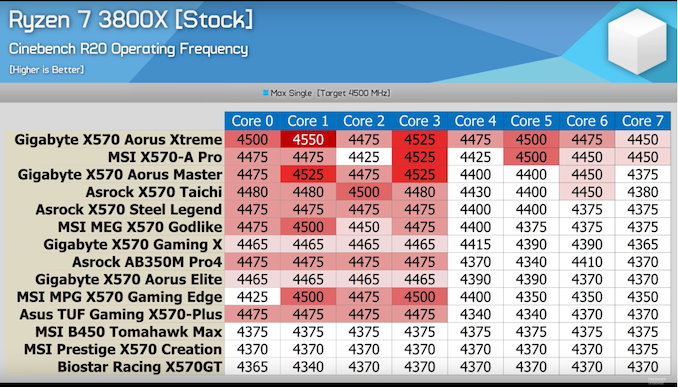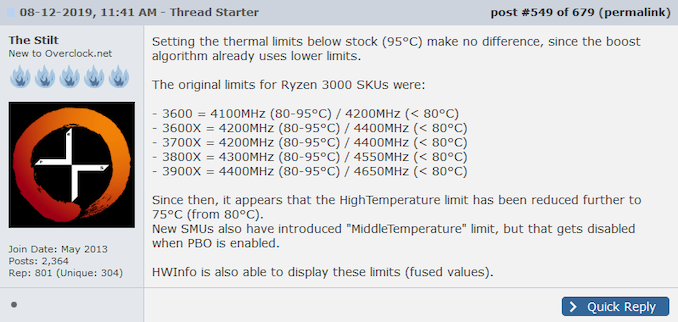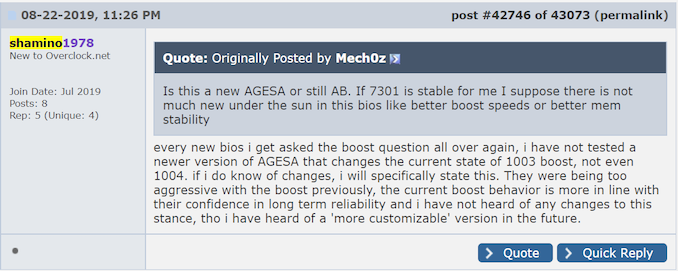Reaching for Turbo: Aligning Perception with AMD’s Frequency Metrics
by Dr. Ian Cutress on September 17, 2019 10:00 AM ESTAMD’s Turbo Issue (Abridged)
So why all this talk about how each company does its Turbo functionality, as well as its binning strategy? I prepped this story with the differences because a lot of our user base still thinks in terms of Intel’s way of doing things. Now that AMD is in the game and carving its own path, it’s important to understand AMD’s strategy in the context of the products coming out.
With that in mind, let’s cover AMD’s recent news.
Ever since the launch of Zen 2 and the Ryzen 3000 series CPUs, AMD has done its usual of advertising core counts, base frequency, TDP, and turbo frequencies. What has occurred since initial launch day reviews and through the public availability has been that groups of enthusiast users, looking to get the most out of their new shiny hardware, have reported that their processors are not hitting the turbo frequencies.
If a processor had a guaranteed 4.4 GHz turbo frequency, users were complaining that their peak turbo frequencies observed were 25-100 MHz less, or in some cases more than 100 MHz down on what was advertised. This kind of drop in frequency was being roughly reported through the ecosystem, but no-one particularly acted on it until these past few weeks, around the same time that AMD had several other news stories going on.
Multiple outlets, such as Hardware Unboxed, noted that the frequencies they were seeing significantly depended on the motherboard used. Hardware Unboxed tested 14 different AMD AM4 motherboards (some X570, others not X570) with a Ryzen 7 3800X, expecting a peak turbo frequency during Cinebench R20 of 4.5 GHz. Only one motherboard was consistent across most CPUs, while a few others were hit and miss.
This obviously plays into some reasoning that the turbo is motherboard dependent, all else being equal. It should be noted that there’s no guarantee that all these motherboards, despite being on the latest BIOSes, actually had AMD’s latest firmware versions in place.
Another outlet, Gamers Nexus, also observed that they could guarantee a CPU would hit its rated turbo speeds when the system was under some form of cold, either chilled water or a sub-zero cooling environment. This ultimately would lead some believe that this relates to a thermal capacity issue within the motherboard, CPU, or power delivery.
The Stilt, a popular user commonly associated with AMD’s hardware and its foibles, posted on 8/12 that AMD had reduced its peak temperature value for the Ryzen 3000 CPUs, and had introduced a middle temperature value to help guide the turbo. These values would be part of the SMU, or System Management Unit, that helps control turbo functionality.
Peter Tan, aka Shamino, a world renowned (retired) overclocker and senior engineer for ASUS’ motherboard division, acknowledged the issue in a forum post on 8/22 with his own take on the matter. He stated that AMD’s initial outlay with its turbo boost behavior was ultimately too aggressive, and in order to ensure longevity of the chip, the boost behavior was in line with what AMD needed to achieve that longevity.
It should be stated here that Shamino is speaking here in his personal capacity.
For those not engrained in the minutae of forum life, the biggest arrow to this issue came from Roman Hartung, or Der8auer, through his YouTube channel. He enlisted the help of his audience to tabulate what frequencies users were getting.
In the survey, the following details were requested:
- CPU
- Motherboard
- AGESA version/BIOS version
- PBO disabled
- Air cooling
Now obviously when it was announced that this survey was going to happen, Roman and AMD discussed behind the scenes the pros and cons about this survey. As you might expect, AMD had some reservations that this survey was in any way going to be fair – it’s about as unscientific as you can get. Naturally Roman argued that these would be real world results with users machines, rather than in-lab results, and AMD should be guaranteeing users on their home machines with specific frequency values. AMD also pointed out that with this sort of survey, you have an inherent selection bias: users who feel negatively impacted by any issue (through AMD’s fault or the users own) are more likely to respond than those that were happy with the performance. Roman agreed that this would be a concern, but still highlighted the fact that users shouldn’t be having these issues in the first place. AMD also mentioned that the Windows version couldn’t be controlled, to which Roman argued that if turbo is only valid for a certain Windows version, then it’s not fair to promote it, however did concede that the best performance was the latest version of Windows 10, and users on Windows 7 will have to accept some level of reduced performance.
Roman and AMD did at least agree on a testing scenario in order to standardize the reporting. Based on AMD’s recommendations, Roman requested from his audience that they use CineBench R15 as a single threaded load, and HWiNFO as the reporting tool, set to a 500 millisecond (0.5 second) polling interval, with the peak frequency from the CPU listed.
The survey ended up with ~3300 valid submissions, which Roman checked one-by-one to make sure all the data was present, screenshots showed the right values, and removed any data points that didn’t pass the testing conditions (such as PBO enabled). The results are explained in Roman’s video and the video is well worth a look. I’ve summarized the data for each CPU here.
| Der8auer's Ryzen Turbo Survey Results | |||||
| AnandTech | 3600 | 3600X | 3700X | 3800X | 3900X |
| Rated Turbo MHz of CPU | 4200 | 4400 | 4400 | 4500 | 4600 |
| Average Survey MHz | 4158 | 4320 | 4345 | 4450 | 4475 |
| Mode Survey MHz* | 4200 | 4350 | 4375 | 4475 | 4525 |
| Total Results Submitted | 568 | 190 | 1087 | 159 | 722 |
| # Results Minus Outliers | 542 | 180 | 1036 | 150 | 685 |
| Results >= Rated Turbo | 210 | 17 | 153 | 39 | 38 |
| % Results >= Rated Turbo | 50% | 9% | 15% | 26% | 6% |
| *Mode = most frequent result | |||||
I have corrected a couple of Roman’s calculations based on the video data, but they were minor changes.
For each CPU, we have the listed turbo frequency, the average turbo frequency from the survey, and the modal CPU frequency (i.e. the most frequently reported frequency). Beyond this, the number of users that reported a frequency equal to the turbo frequency or higher is listed as a percentage.
On the positive, the modal reported CPU frequency for almost all chips (except the 3900X) is relatively close, showing that most users are within 25-50 MHz of the advertised peak turbo frequency. The downside is that the actual number of users achieving the rated turbo is quite low. Aside from the Ryzen 5 3600, which is 50%, all the other CPUs struggle to see rated turbo speeds on the box.
As you might imagine, this data caused quite a stir in the community, and a number of vocal users who had invested hard earned money into their systems were agonizingly frustrated that they were not seeing the numbers that the box promised.
Before covering AMD’s response, I want to discuss frequency monitoring tools, turbo times, and the inherent issues with the Observer Effect. There’s also the issue of how long does turbo need to be active for it to count (or even register in software).













144 Comments
View All Comments
ajlueke - Tuesday, September 17, 2019 - link
More specifically, I was referring to this test from the article."Because of the new binning strategy – and despite what some of AMD's poorly executed marketing material has been saying – PBO hasn't been having the same effect, and users are seeing little-to-no benefit. This isn’t because PBO is failing, it’s because the CPU out of the box is already near its peak limits, and AMD’s metrics from manufacturing state that the CPU has a lifespan that AMD is happy with despite being near silicon limits."
What silicon limits exactly? AMDs marketing material has always indicated that a CPU will boost until it reaches either the PPT, TDC, EDC, or thermal limits. If none of those are met, it will boost until Fmax, which it simply will not exceed. Now, in a single threaded workload, the user is almost never at a PPT,TDC, EDC or thermal limit, and seem to be just shy of Fmax anyway. Now, if the user enables the auto-oc feature and extends Fmax by 100, 150 or 200MHz...nothing happens. The identical clockspeed and performance are observed.
I see the same thing happen in multicore on my 3900X. I normally hits the EDC and PPT limits under standard boosting. If I remove them, with precision boost overdrive, it does boost higher, but not by much. It again seems to stop a certain point. Again, EDC, TDC and PPT motherboard limits are not met, I am certainly not at Fmax, and the chip is under 70C, but it stops nonetheless. Nothing I can do makes it boost further.
"The Stilt", seems to mention the silicon fitness monitoring feature (FIT) in his "Matisse Strictly Technical" post on overclock.net. FIT appears to be a specific voltage limit for high and low current the CPU cannot exceed. This has never been included in AMDs documentation, and would help explain why the processor's stop boosting when according to AMD's own documentation, they should keep on going. So what exactly is this feature, and how does it work? I think that answer would do a great deal to alleviate user confusion.
mabellon - Tuesday, September 17, 2019 - link
>> "To a certain extent, Intel already kind of does this with its Turbo Boost Max 3.0 processors... [the] difference between the two companies is that AMD has essentially applied this idea chip-wide and through its product stack, while Intel has not, potentially leaving out-of-the-box performance on the table."What does this mean? What has Intel not done that AMD has done? Both have variable max frequency per core. Both expose this concept to the OS. Both rely on the same Window scheduler. What are you alluding to is different here?
It seems to me that Intel's HEDT platform with Turbo 3.0 is very much similar to AMD's implementation in the sense of having certain cores run faster. @Ian how is performance left on the table for Intel here? (Intel non HEDT is obviously stuck on Turbo 2.0 which is at a disadvantage)
Targon - Tuesday, September 17, 2019 - link
The majority of Intel chips are multiplier locked, so there isn't any real overclocking ability to speak of. It is only the k chips that users can overclock. AMD on the other hand, has PBO which is more advanced when it comes down to it.edzieba - Thursday, September 19, 2019 - link
"What does this mean? What has Intel not done that AMD has done?"Intel picks the maximum 'turbo' bin as the lowest that any core can achieve. AMD picks their maximum boost bin as the highest that any single core could achieve. 'Turbo 3.0' pre-selected two cores that were able to clock above the all-core turbo bin and allowed them to clock higher for lightly threaded workloads.
Jaxidian - Tuesday, September 17, 2019 - link
Is this WSL tool available for us to use? I'd love to have a better view of what speeds my cores could hit with a tool like this. In fact, I'd probably use it to map out all 12 cores (disabling 11 of them at a time). Obviously even that wouldn't quite give the whole picture, but it would be an interesting baseline map to have for my 3900x chip.Jaxidian - Tuesday, September 17, 2019 - link
I got my "no" answer here: https://twitter.com/IanCutress/status/117401405985..."It's a custom kludgy thing for internal use."
MFinn3333 - Tuesday, September 17, 2019 - link
I miss the old days when I would just push the Turbo frequency on my 286 and the CPU would go from 10MHz to 12MHz. Sure occassionally chip poppped off from the Glue but it was totally worth it to play Dune 2.sing_electric - Tuesday, September 17, 2019 - link
"Turbo, in this instance, is aspirational. We typically talk about things like ‘a 4.4 GHz Turbo frequency’, when technically we should be stating ‘up to 4.4 GHz Turbo frequency’."This is true, but EXACTLY the problem. The marketing teams at AMD, Intel and everyone else KNOW that when you see "3.6 GHz / 4.5 GHZ Turbo" written on a box, your eye falls to the second, larger number, and that's what sticks in your head.
Why should the consumer know that some of the numbers on the box (core count, base freq) are guaranteed, but some (turbo) aren't? That makes no sense and is borderline deceptive. And this doesn't just matter to the fairly small, tech savvy group of people who buy a processor alone in a box - here's how Dell lists the processor on its base config XPS 13 laptop when you go to "Tech Specs & Customization"
"8th Generation Intel® Core™ i5-8265U Processor (6M Cache, up to 3.9 GHz, 4 cores)"
Dell doesn't even bother LISTING the base frequency, even when you click to get more detail - how's a consumer supposed to gauge how fast their processor is? (To their credit, Apple, HP and Lenovo all list base frequency and "up to" the turbo).
Turbo is a great technology for getting the most out of limited silicon, but both AMD and Intel are, while not QUITE being untruthful, certainly trying to put their products in as good of a light as possible.
DigitalFreak - Tuesday, September 17, 2019 - link
That's marketing for you. Step as close to the "deceive the customer" line as possible without getting sued.Jaxidian - Tuesday, September 17, 2019 - link
I'm looking at the retail box for my 3900x right now. The only thing it says about frequencies is "4.6 GHz Max Boost, 3.8 GHz Base". There is no "up to" verbiage anywhere on the box. From a FTC advertising standpoint, the 4.6GHz should be guaranteed even if only under nuanced "limited single-core" and "with specific but reasonable motherboard, cooling, and software" scenarios.While this is a very good article and I generally have very few issues with AMD's new approach here, I'm of the belief that legally, a 3900x should be guaranteed to hit 4.6GHz when in a specific-yet-real-world scenario. I don't mean $100 mobos with $25 coolers should be able to hit it. But a better-than-budget x570 motherboard using the stock cooler with proper updates on a supported OS should absolutely hit 4.6GHz with certain loads. Otherwise, I think there's a real legal issue here.
All this said, I am now seeing 4.6GHz from time to time on my 3900x with ABBA on my x570 Aorus Master, so we're good here. Never saw higher than 4.575 before ABBA.